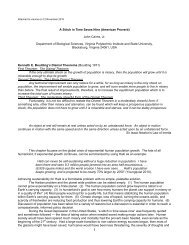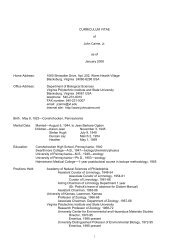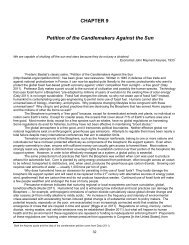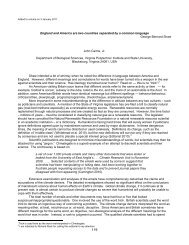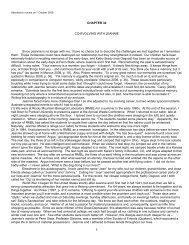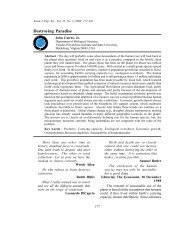View - ResearchGate
View - ResearchGate
View - ResearchGate
You also want an ePaper? Increase the reach of your titles
YUMPU automatically turns print PDFs into web optimized ePapers that Google loves.
281Article 34With kind permission of Springer Science and Business Media (Kluwer Academic Publishers)Speculations in Science and Technology 16(3):163–170, 1993Communication and Status: The Dilemma of an EnvironmentalScientistJohn Cairns, Jr.University Center for Environmental and Hazardous Materials Studies, Virginia Polytechnic Institute and StateUniversity, Blacksburg, VA 24061, USA‘Hard science’ is quantitative and based on numbers, but ‘soft science’ requires qualitative judgment. Theharder the science, the higher the status. There is, however, another aspect of assigning status: degree ofindependence. Environmental scientists typically study complex multivariate problems beyond the capabilitiesof a single discipline. They form interdisciplinary teams intended to interact and resolve problems.The connections and synthesis that environmental scientists regard as positive attributes of interdisciplinarywork, ‘hard scientists’ judge as marks of incompetence and insecurity. This situation is remarkablyanalogous to the gender differences in communicating.INTRODUCTIONThe genesis of this article was a talk by the Reverend Catherine C. Snyder at the BlacksburgUnitarian Fellowship based on a book by sociologist Deborah Tannen. 1 As the talk progressed, Iwas struck by the correspondence between communication among women and communicationamong interdisciplinary team members, and by the correspondence between the problems ofcommunicating from one gender to the other and those of interdisciplinary practitioners communicatingto disciplinary practitioners. For women, being understood is [the] most important aspect ofcommunication; for men, being understood is less important than establishing status. For interdisciplinaryprojects, it is essential that all team members understand what each is doing. A projectthat does not achieve at least some level of mutual understanding is doomed to failure. As in thecase of ‘communication’ between men, within an area of specialization, status is achieved bymaking the listener struggle to comprehend the message, and, if the message is not understood, itis regarded as a deficiency not of the speaker but of the listener.When the Reverend Snyder talked about communication in her address, I had a vivid flashbackto a departmental seminar I attended several decades ago presented by an outside speaker on arather esoteric area of genetics. On the way out of the seminar room, one of the senior facultymembers commented on how scholarly and scientific the seminar had been. Since I had beenthoroughly confused, I asked the senior member (not a geneticist) what the basic message hadbeen. Not only was he unable to tell me, but he saw no contradiction between this inability tosummarize the talk and his evaluation of the seminar. Intrigued by this response, I questioned twodepartmental geneticists about the ‘take-home’ message and found, to my glee, that neither had





